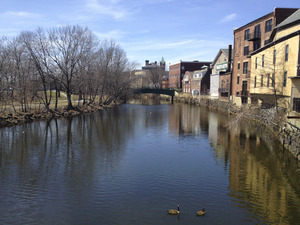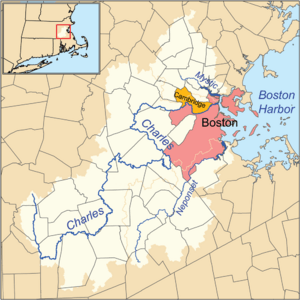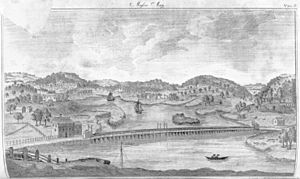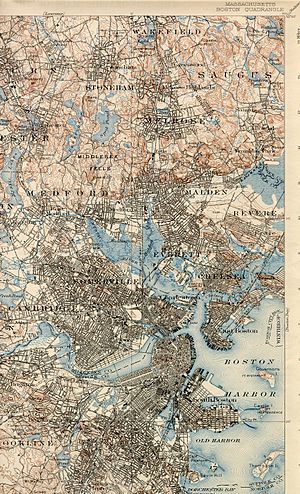Mystic River facts for kids
Quick facts for kids Mystic River |
|
|---|---|

Mystic River as seen from the Cradock Bridge
|
|

Boston Harbor basin, showing the Mystic River drainage
|
|
| Country | United States |
| State | Massachusetts |
| District | Middlesex County |
| Municipalities | |
| Physical characteristics | |
| Main source | Lower Mystic Lake |
| River mouth | Boston Harbor |
| Length | 7 mi (11 km), roughly east-west |
| Basin features | |
| Basin size | 76 sq mi (200 km2) |
| Tributaries |
|
The Mystic River is a 7.0-mile-long (11.3 km) river in Massachusetts, in the United States. Its name comes from the Wampanoag word Muhs-uhtuq, which means "big river." This name makes sense because the river is a tidal river, meaning its water level changes with the ocean's tides.
The Mystic River flows north of Boston, similar to the Charles River. It starts at the Lower Mystic Lake and flows through several towns. These include Chelsea, Charlestown, Everett, Medford, Somerville, and Arlington. Finally, it joins the Charles River to form part of Boston Harbor.
The area that drains into the Mystic River is called its watershed. This watershed covers 76 square miles (200 km2) and includes 44 lakes and ponds. The largest of these is Spot Pond in the Middlesex Fells. Many parts of the river's banks are protected areas. They are managed by the Massachusetts Department of Conservation and Recreation and offer places for outdoor activities.
The Mystic River has been used by industries for a long time. Because of this, it has faced problems with water quality. Some parts of the river are currently being cleaned up. This cleanup is happening as part of the construction of the new Encore Boston Harbor casino in Everett.
Contents
History of the Mystic River
Long before written records, Native Americans used the river for fishing. They built special traps called weirs to catch fish like alewives. Later, early European settlers also used these fish to help fertilize their crops.
In 1631, the first ship built by Europeans in Massachusetts was launched from the Mystic River's banks. It was called the Blessing of the Bay. A few years later, in 1637, the first bridge was built over the river. Nearby towns argued about who should pay for it for over a hundred years!
The River's Role in the American Revolution
The Mystic River played an important part in the American Revolution. On September 1, 1774, about 260 British soldiers rowed up the river from Boston. They landed near Winter Hill in what is now Somerville. From there, they marched to the Powder House, where a lot of gunpowder was stored. The soldiers took the gunpowder, which made the local people very angry. This event is known as the Powder Alarm.
In 1775, two more important battles happened near the river. The Battle of Chelsea Creek took place in May. In June, the British attacked by the river's beach during the famous Battle of Bunker Hill.
Industrial Growth and Change
In 1805, the Middlesex Canal was built. This canal connected the Mystic River and the Charles River to the Merrimack River in Lowell. This was a big step for transportation.
During the 1800s, shipbuilding became very important along the Mystic River. Ten shipyards built more than 500 clipper ships. Shipbuilding was busiest in the 1840s. Ships like schooners and sloops carried timber and molasses for rum distilleries between Medford and the West Indies.
However, by 1865, too much fishing and pollution almost completely stopped commercial fishing in the river.
Dams and Bridges
The banks of the Mystic River used to have large salt marshes. But in 1909, the first dam, called Craddock Locks, was built across the river. This changed the salt marshes into freshwater marshes and allowed more building along the river.
Another important dam, named for Amelia Earhart, was built in 1966. This dam has three locks that let boats pass through. It also has pumps that push fresh water out to the harbor, even when the tide is high. Sometimes, the dam operators leave the locks open so fish can pass. There is also a fish ladder to help fish move, but it has never worked properly. The dam is not open to the public.
In 1950, the Maurice J. Tobin Bridge was finished. This large bridge crosses the Mystic River, connecting Charlestown and Chelsea.
Wildlife and Pollution
The Mystic River used to be home to many kinds of fish. These included salmon, alewife, blueback herring, striped bass, bluefish, smallmouth bass, largemouth bass, bluegill, and carp. Most of these fish still live in the river today. However, pollution and the building of dams have greatly harmed their populations.
In the past, pollution came from mills and small shipyards. Today, the main source of pollution comes from drainage from cities and towns in the watershed. Many records of nearby drainage pipes have been lost, or their changes are not documented.
People once said there were so many herring in the Mystic River that you could walk across their backs. But today, the number of herring is much smaller than it used to be. Pollution has caused high levels of bacteria and cloudy water, making it hard for fish to thrive.
The Mystic River in Popular Culture
The Mystic River has inspired many writers and artists:
- In 1844, writer Lydia Maria Child wrote the famous poem "Over the River and Through the Wood." It describes her trip across the Mystic River to her grandfather's house. Her grandfather's house still stands near the river in Medford.
- John Townsend Trowbridge's popular 1882 novel, The Tinkham Brothers' Tide-Mill, is set along the river. It shows a time when saltwater still reached the Mystic Lakes.
- The river is a key part of Dennis Lehane's mystery novel of the same name. Later, Clint Eastwood directed a well-known movie based on the book.
- In the 1861 poem "Paul Revere's Ride" by Henry Wadsworth Longfellow, Paul Revere rides along the banks of the Mystic River.
Crossings Over the Mystic River
Many bridges and other structures cross the Mystic River. Here are some of the main crossings:
| Crossing | Carries | Location | Built |
|---|---|---|---|
| Tobin Bridge | Charlestown to Chelsea | 1950 | |
| Malden Bridge | Charlestown to Everett | 1963 (restored 2010–2014) | |
Commuter Rail |
Somerville to Everett | Original 1849 | |
| Amelia Earhart Dam | No public access | Somerville to Everett | 1966 |
Commuter Rail and MBTA Orange Line |
Somerville to Medford | Replaced in 1975 | |
| Wellington Bridge | Somerville to Medford | 1935, reconstructed 1979 | |
| Medford | 1988 | ||
| Medford | |||
| Cradock Bridge | Medford | ||
| Medford Pipe Bridge | Pedestrians, piped water | Medford | 1897 |
| Medford | 1906 | ||
| Winthrop Street | Medford | ||
| Medford | 1906 | ||
| Somerville to Medford | Original in 1835 | ||
| Boston Avenue | Somerville to Medford | Former site of Middlesex Canal crossing | |
| River Street / Harvard Avenue | Arlington to Medford | ||
| Arlington to Medford |



